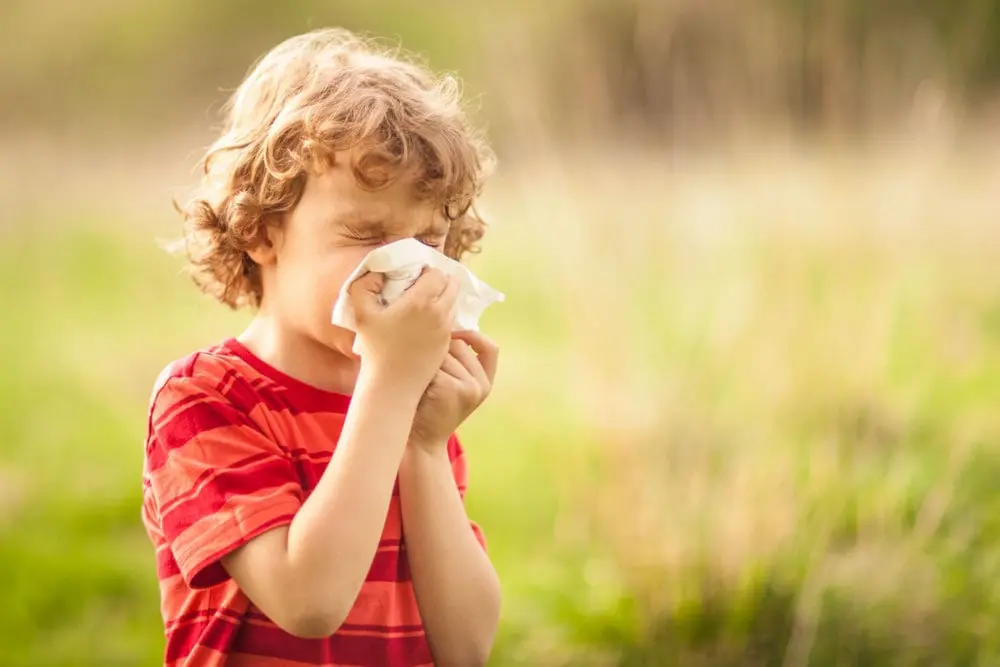What Is BENADRYL® (Diphenhydramine HCl) And What Can It Be Used For?
Oral BENADRYL® is an antihistamine that is used for the relief of symptoms related to hay fever, upper respiratory allergies, or cold symptoms.1,2 The active ingredient in BENADRYL®, diphenhydramine hydrochloride, works by blocking histamine that your body makes during an allergic reaction, and by drying secretions related to symptoms like watery eyes and runny nose.
Topical BENADRYL® is applied to the skin for relief of itching associated with insect bites, sunburn, scrapes, minor skin irritation, minor burns, and rashes caused by poison ivy, poison oak, and poison sumac. Topical BENADRYL® also contains the active ingredient diphenhydramine hydrochloride, which works as an analgesic (pain reliever) when applied topically. Several topical BENADRYL® products, including sticks, sprays, and creams, also contain the active ingredient zinc acetate, which works as a skin protectant.
BENADRYL® for Allergies
BENADRYL® can be used to help relieve allergy symptoms caused by many different types of common allergens.
Seasonal Allergies
Seasonal allergies are triggered by mold spores and pollens from trees, grass, and weeds. Hay fever is another name for allergic rhinitis that is caused by seasonal allergies. Depending on what you are allergic to and where you live, you may experience seasonal allergies in more than one season.3
Pollen
Depending on the season and the area, trees, grasses, and weeds release pollen that can cause allergic reactions for many people. Pollen is a fine yellowish powder that is transported from plant to plant to fertilize other plants of the same species. Pollen can be transported by wind, animals, and insects.3 When breathed in, pollen can cause you to have allergy symptoms such as sneezing and a runny nose.
Ragweed
Ragweed is a type of plant that can cause allergies in many people. There are 17 different types of ragweed that grow throughout the United States, and levels are higher in the late summer and fall.4
Perennial Allergies
Mold
In people who have a mold allergy, being exposed to mold indoors or outdoors can cause an allergic reaction. Mold allergies can occur year-round.5
Pet Dander
Pet allergies are caused by an allergic reaction to proteins found in an animal's dander, saliva, or urine. Managing pet allergy symptoms can be made easier with some simple indoor allergy tips such as keeping pets off of furniture and cleaning carpets.6
Dust Mites
Dust mites are tiny spider-like creatures that thrive in mattresses, bedding, carpets, and upholstered furniture.7 They are a common indoor allergy trigger that can aggravate symptoms year-round.
Allergy Symptoms That BENADRYL® Treats
Allergy symptoms can be very bothersome, and BENADRYL® can help. BENADRYL® can be used to help treat the following allergy symptoms:
Itchy, watery eyes
Itchy nose
Runny nose
Sneezing
BENADRYL® for Itchy Skin Symptoms
BENADRYL® topical medicines can be used to treat itchy skin and oozing associated with various skin ailments. Follow product directions. Do not use on large areas of the body. Following are some examples of skin conditions that BENADRYL® topical medicines can help treat.
Insect and Bug Bites
Most insect and bug bites are mild, and symptoms can be treated at home. BENADRYL® topical medicines can help relieve itching associated with insect and bug bites.8
Minor Burns
Itching can be a symptom people experience as a minor burn heals. BENADRYL® topical medicines can help alleviate itching associated with minor burns.9
Sunburn
Sunburns can often get itchy as your skin begins to heal and scratching them can cause you even more pain. Luckily, BENADRYL® topical medicines can help alleviate itching associated with sunburns.9
Minor Cuts & Scrapes
Minor cuts & scrapes can become itchy as they form scabs and heal. It’s important not to scratch so your wound can heal properly. BENADRYL® topical medicines can help relieve itching and pain associated with minor cuts.10
Rashes Due to Poison Ivy, Poison Oak, and Poison Sumac
Rashes due to poisonous plants, including poison ivy, poison oak, and poison sumac can be very itchy, and they can ooze or seep discharge from of the affected skin area. BENADRYL® topical medicines can help alleviate the itching and can help dry the oozing and weeping of rashes caused by poison ivy, poison oak, and poison sumac.11
BENADRYL® for Cold Symptoms
As your body works to fight off the virus that causes the common cold, you will likely experience symptoms such as congestion & a runny nose. BENADRYL® oral medicines can be used to relieve common cold symptoms, such as the following:2
Runny Nose
Runny nose is caused by mucus being discharged out of the nose with allergies or the common cold.
Sneezing
Sneezing can be a symptom of a cold, and it is triggered when the mucous membranes of the nose or sinuses are irritated.
Congestion
The common cold often causes congestion of the sinuses or nasal passageways. This can happen when excess fluid causes the blood vessels and mucous membranes in the sinuses or nasal passageways to swell.
Sinus Pressure
Sinus pressure behind the eyes and cheeks can happen when excess fluid causes the blood vessels in the mucus membrane to swell. Sinus pressure can make it difficult to breathe comfortably through the nostrils.
Which BENADRYL® Product Should I Take?
Determining which BENADRYL® product is right for you depends on the ailment being treated as well as the symptoms and age of the person being treated.
Try BENADRYL® adult allergy products for adults with allergy symptoms related to hay fever, upper respiratory allergy, or cold symptoms such as sneezing, runny nose, itchy or watery eyes, or itchy throat.
For congestion or sinus pressure, BENADRYL® Allergy Plus Congestion might be right for you. It contains a powerful decongestant to help relieve sinus congestion and sinus pressure.
BENADRYL® children’s allergy products are a good option for children ages 6-11 years experiencing hay fever and allergy symptoms such as runny nose, sneezing, itchy or watery eyes, itchy throat, or itchy nose.
BENADRYL® topical products are best if you need a topical analgesic that temporarily relieves itching associated with insect and bug bites, sunburn, scrapes, minor skin irritations and burns, and rashes caused by poison ivy, poison oak, and sumac.
How To Use BENADRYL® Products
For adults and children ages 6 years and older, follow the directions according to the packaging. Do not use more than one diphenhydramine product at the same time.
For BENADRYL® oral medicines, follow the instructions on the package. Do not take more than 6 doses in 24 hours.
Use BENADRYL® children’s allergy products for children ages 6-11 years, and follow the directions on the package. Do not give more than 6 doses in 24 hours. Do not use for children under 2 years, and do not give to children ages 2-5 years unless directed by a doctor.
Use BENADRYL® topical products for adults and children 2 years of age and older. Apply to the affected area on the skin, not more than 3-4 times daily.
Find more information on BENADRYL® dosing here.
References
Mayo Clinic. Allergies. August 4, 2020. Accessed from: https://www.mayoclinic.org/diseases-conditions/allergies/symptoms-causes/syc-20351497
Mayo Clinic. Cold or allergy: Which is it? February 17, 2022. Accessed from: https://www.mayoclinic.org/diseases-conditions/common-cold/expert-answers/common-cold/faq-20057857
Mayo Clinic. Seasonal allergies: Nip them in the bud. April 16, 2020. Accessed from: https://www.mayoclinic.org/diseases-conditions/hay-fever/in-depth/seasonal-allergies/art-20048343
American College of Asthma, Allergy, and Immunology. Ragweed Allergy. April 23, 2018. Accessed from: https://acaai.org/allergies/allergic-conditions/ragweed-allergy/
Mayo Clinic. Mold allergy. June 21, 2021. Accessed from: https://www.mayoclinic.org/diseases-conditions/mold-allergy/symptoms-causes/syc-20351519
Mayo Clinic. Pet allergy. August 4, 2021. Accessed from: https://www.mayoclinic.org/diseases-conditions/pet-allergy/symptoms-causes/syc-20352192
Asthma and Allergy Foundation of America. Dust Mite Allergy. October 2015. Accessed from: https://www.aafa.org/dust-mite-allergy/
American Acacemy of Dermatology Association. Tips to prevent and treat bug bites. Accessed from: https://www.aad.org/public/everyday-care/injured-skin/bites/prevent-treat-bug-bites
UpToDate. Patient education: Skin burns (Beyond the Basics). July 26, 2021. Accessed from: https://www.uptodate.com/contents/skin-burns-beyond-the-basics/print?source=outline_link&view=text&anchor=H14
Mayo Clinic. Cuts and scrapes: First aid. November 17, 2021. Accessed from: https://www.mayoclinic.org/first-aid/first-aid-cuts/basics/art-20056711
Cleveland Clinic. Poison Ivy, Poison Oak and Poison Sumac. August 4, 2020. Accessed from: https://my.clevelandclinic.org/health/articles/10655-poison-plants-poison-ivy--poison-oak--poison-sumac


